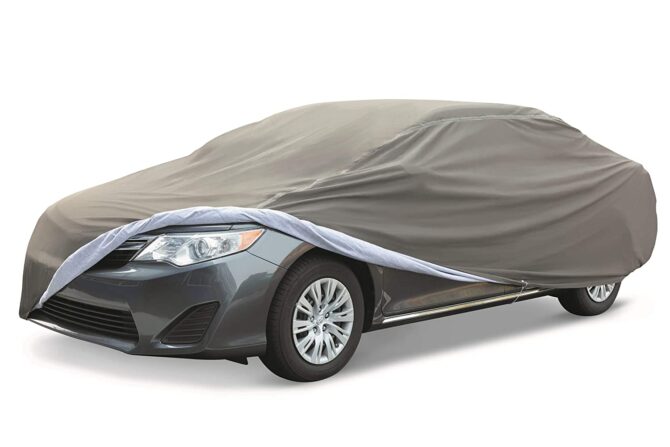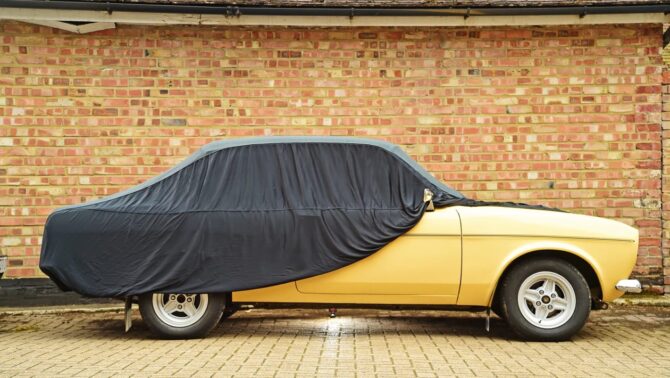
Every car owner wants to protect his car from damage. Every year, the auto industry spends a lot of money on constant tuning, car care, accessories, and safety products for cars. One of the most popular vehicle protection products is a car cover.
A car cover is a versatile accessory that helps to save the paintwork, overheating in the sun, and the harmful effects of rainfall and dirt. Ultraviolet rays can significantly damage your vehicle’s paintwork, increasing repair and maintenance costs. Car paint fades over time, and the quality of the coating becomes much worse. It is also unfavorable to leave the car in the sun – it overheats too much.
The best car covers can completely solve the above problems. If you do not have the opportunity to put the car in the garage, then car covers will be an excellent way out of this situation. Believe me, your car will feel no much better under the cover!
The main characteristics of car covers

Source: pinterest.com
Car covers vary among manufacturers in many ways. They, like regular clothing, come in standard sizes from S to XXL, depending on the size of the vehicle they are purchased for. Each manufacturer also produces covers from different materials, which differ in overall density, water resistance, and mechanical damage. The most recognized are the waterproof type of car covers, according to professionals from pagegarage.com.
When initially choosing a car cover, you must immediately pay attention to the following parameters:
- the quality of the material itself. The first thing that is appreciated in the material for the cover is its density. You can determine this simply by touch;
- the technology of applying a double seam on a product is also considered a sign of high quality and resistance to wear;
- the material of the car cover should not allow moisture to pass through – this is one of the first parameters for determining a quality product;
- it is recommended to use nylon threads for the cover manufacturing as they are more elastic and stable. When choosing, pay attention to this parameter as well;
- at the bottom of the car cover, there must be a dense elastic band sewn into the fabric. It prevents the cover from rolling off the vehicle and protects it even more effectively. The density of the elastic and the force of its tension should be felt, but not too tight;
- the reverse side of the cover for a car must have a special lining that prevents the hard material from scratching the cover, and also creates an additional barrier to protect it.
- The latter parameters are present only in multi-layer car covers. They are the most acceptable for use, as they softly fit the car and completely preserve the paintwork in its original form.
There are also more budget options for covers – one-sided. Their difference can only be that they do not have the very bottom lining, which protects against scratches and makes the structure denser.
Typically, many manufacturers make car covers that are moisture-tight, but also completely trap air. It is not right. The good car cover should “breathe”, be fully ventilated so that mold does not develop on your car and the paint does not begin to flake off.
What materials are used to make the car cover?

Source: covercraft.com
Regardless of what fabric was chosen and what size of the car cover will be produced, it must be durable and sewn using high-quality and proven technology. In the production of these car accessories, not so many fabrics are used. The most popular are polyvinyl chloride (PVC, polyurethane) type materials such as oxford and tarpaulin. The main material for such a fabric becomes a polymer and a reinforced mesh, due to which the finished product is distinguished by high density, air permeability and absolutely does not allow moisture to pass through itself.
Polyester and polyurethane, present in the composition of such fabrics, make the structure denser and also allow to increase the number of layers when the material is applied to the mesh. In this way, the strength of the final fabric can be adjusted to produce car covers of varying degrees of density and thickness.
This PVC fabric has excellent elasticity, which also goes well with car tarpaulins. Any pattern can be applied to its surface, which is a pleasant surprise for lovers of intricate designs even in such details.
PVC-type material does not burn, withstands temperatures from -50 to +50 degrees Celsius, and absolutely does not lose its shape.
Varieties of car covers and their sizes

Source: autoexpress.co.uk
Car covers are widely used by car enthusiasts – they perfectly protect your car from the harmful effects of direct sunlight, large-scale pollution, and dust getting into the internal parts of the car.
Car covers differ, first of all, in the quality of the fabric, the type of sewing, and the size.
So how to choose the right cover for your car?
Car covers dimensions include the standard range S, M, L, XL. They are further subdivided into the same model tents for SUVs and sedans. Depending on the body type, you can choose the size of the car cover that will perfectly match the size of your car.
As a rule, the dimensions of car covers are selected immediately upon purchase – an experienced consultant will help you without any problems to buy a car cover that will perfectly match the size of your car. To do this, you need to know the car model and its body type – the most important parameters for a successful purchase!
In order for the car cover not only to fit in size but also to be useful for the car when choosing it, you need to take into account several basic nuances:
- we have already spoken about the quality of the fabric – it must be dense, waterproof, but it is excellent to let air through so that the paintwork does not deteriorate from condensation or overheating;
- the patterns of the cover must be free so that the product can be easily put on the car;
- the presence of an elastic band located around the entire perimeter of the car cover, which will prevent it from sliding off the car and even more reliably protect it from dust and small debris;
- pockets for mirrors. In a high-quality car cover, they must be present, so as not to damage the car mirrors when pulling. If you choose a car cover of a suitable size, the pockets will be located just above the mirrors;
- for ease of use, high-quality covers also have zippers through which you can facilitate access to the trunk. If the car cannot be put into the garage, then to get into the trunk, you will not need to completely remove the entire tarpaulin – you just need to open the zipper!
So, a car cover will fulfill its main function as much as possible if it is made of high-quality material, have a soft lining that does not damage the car, fix well in the lower part, have functional elements for accessing the car, do not let UV rays and water pass through, but it is great to let air through. All these parameters, if you take them into account when buying a car cover, will allow you to purchase an accessory that will protect nothing worse than an ordinary garage!
How to properly take on a car cover?
Taking on a car cover is easy enough, even if you are the lucky owner of a tall SUV. You need to get the cover out of the storage area (it is better if it is a cool place with minimal penetration of sunlight) and put it on top of the car. Next, unfold the cover between the bumpers – front and rear, and put on them, fixing the elastic at the bottom. If the cover has pockets for mirrors, then you can easily adjust it so that the mirrors are in the right place.
Car cover maintenance is very simple. You can clean it with plain running water – it doesn’t need to be cleaned too often. There is also no need to purchase any professional care products – plain water and common household chemicals will allow you to clean the cover quickly and inexpensively.
Summary
Car covers are one of the best ways to protect your car without a garage, especially during the spring/fall season. A properly selected cover will be the best and most reliable barrier for your car, will keep it clean, and prevent the paintwork from fading in the sun and being damaged by precipitation. Take care of your car – a quality cover will become its best friend for years to come!



